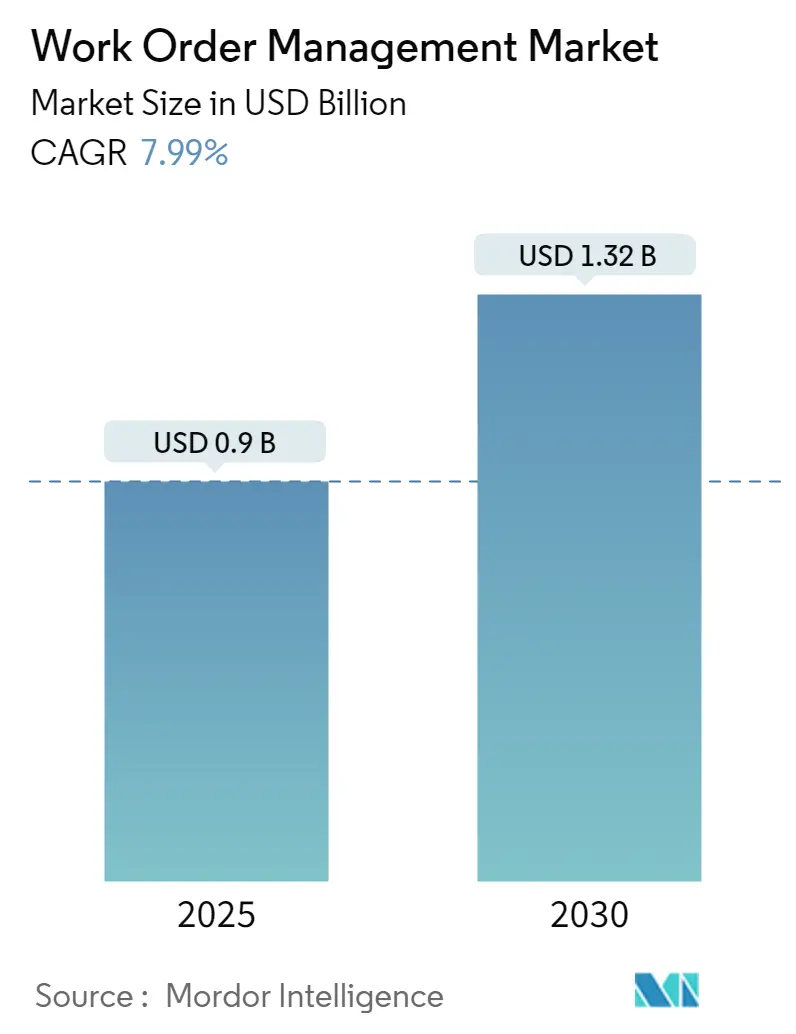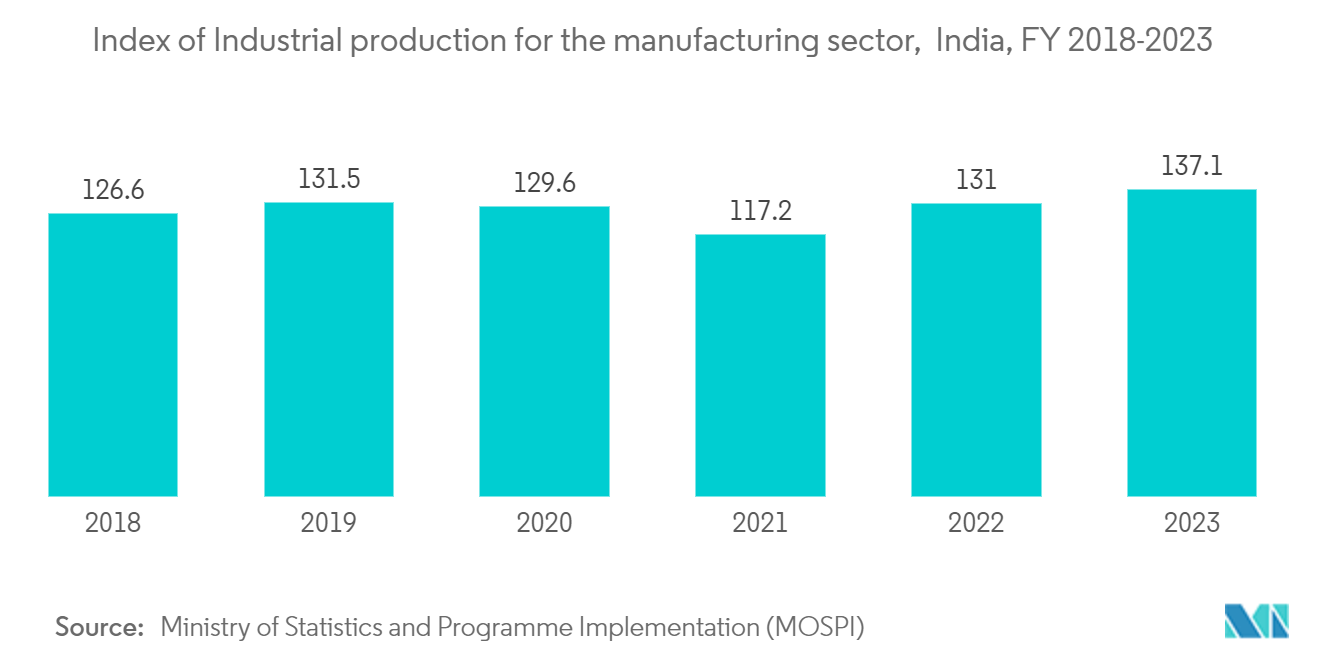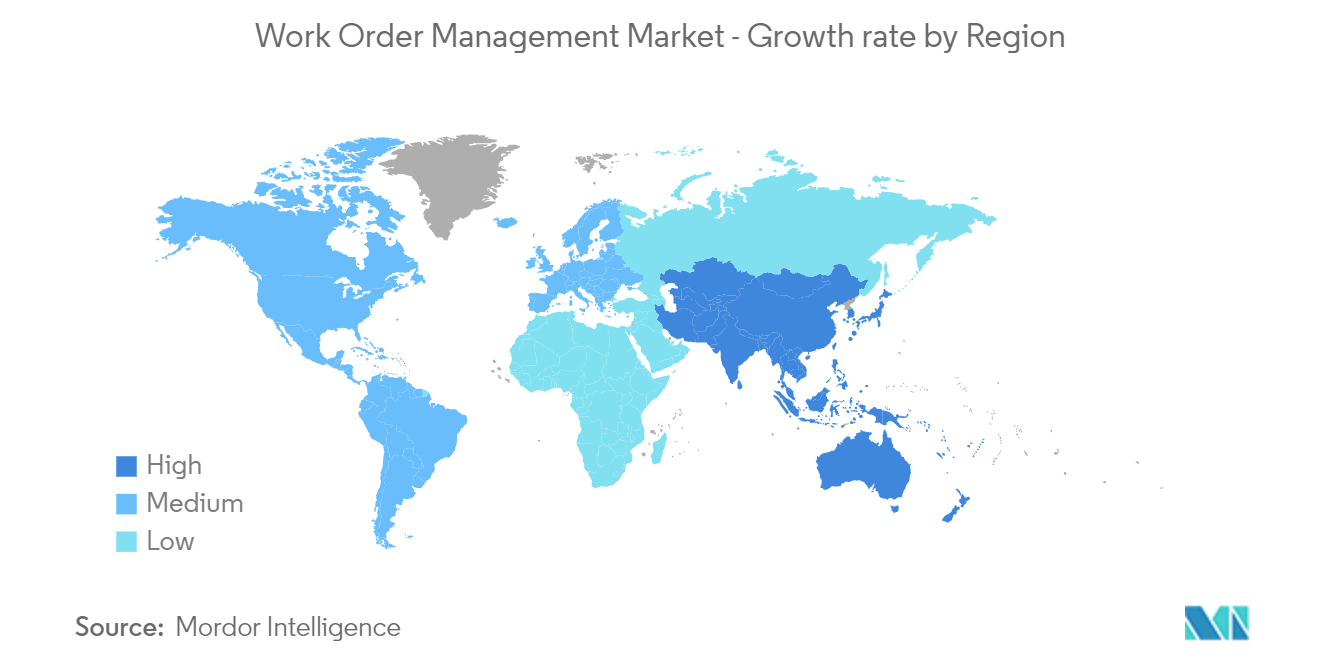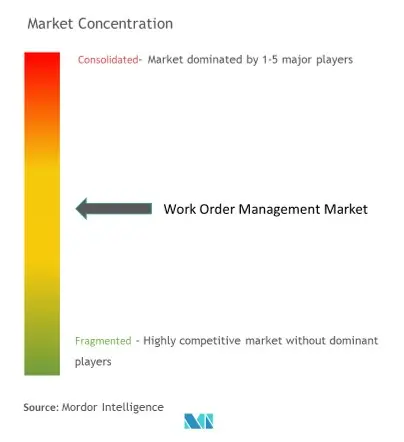Work Order Management Market Analysis
The Work Order Management Market size is estimated at USD 0.90 billion in 2025, and is expected to reach USD 1.32 billion by 2030, at a CAGR of 7.99% during the forecast period (2025-2030).
Enterprises worldwide are increasingly moving towards digital transformation, adopting various solutions to oversee maintenance and management.
- Work order management is scheduling, planning, tracking, and managing work orders for a business's maintenance, installation, and repair tasks. Reducing costs, equipment downtime, and optimizing operations are augmenting the digitalization of facilities across the globe. Adopting a work order management system allows enterprises to opt for preventive maintenance, making it easy to place service requests and gain real-time updates.
- The market is experiencing substantial growth marked by a rising trajectory fueled by increased consumer demand attributed to the growing prevalence of organizations embracing work order management software to streamline maintenance operations, enhance asset performance, and optimize overall operational efficiency.
- Furthermore, the increasing requirement to have managed work orders, better execution of projects, increasing requirement among businesses across industries to manage and centrally track orders and increasing focus towards cloud-based solutions for work order management system are key factors driving the growth of the market.
- However, the work order management market growth is challenged by the integration complexities of work order management with existing systems, data security concerns, and a lack of skilled personnel. The market growth is expected to be accelerated by addressing these challenges with seamless integration of evolving technologies.
- The COVID-19 pandemic had a mixed impact on the studied market. The transition to remote work posed challenges in accessing and updating work orders, impacting productivity and communications. The industries like hospitality and travel experienced downturns, leading to decreased demand for these solutions. Whereas the adoption of cloud-based work order management solutions facilitated remote access and collaborations, becoming essential for managing distributed teams and ensuring business continuity in industries like manufacturing, e-commerce, healthcare, and others.
Work Order Management Market Trends
Manufacturing Expected to Exhibit Significant Adoption
- Work order management becomes an integral part of manufacturing operations, guiding the execution of production tasks, resource allocation, and scheduling. However, with the rise of digitalization, manufacturers are increasingly embracing technologies to streamline and optimize work order management.
- The manufacturing industry is witnessing a significant surge in adopting work order management solutions. This trend is driven by a multitude of factors, all pointing toward enhanced efficiency, cost optimization, and ultimately, improved effectiveness.
- Industry 4.0 is transforming industries, from legacy systems to smart components and machines, to promote digital factories and the development of an ecosystem of connected plants and enterprises. Industry 4.0 has persuaded OEMs to adopt IoT across their operations. The benefits offered by IoT in the manufacturing industry drive the adoption rates, such as increased machine utilization, predictive maintenance and production, data analytics, monitoring, automation, and cost benefits.
- Moreover, in November 2022, China's Ministry of Industry and Information Technology approved three new national manufacturing innovation centers. They also stated that these centers would focus on vital generic technologies and boost technological research and development in these industries. Also, the ministry stated that it would guide the new manufacturing innovation centers in strengthening their capabilities to seek technological innovation to provide critical support for the high-quality development of primary fields in manufacturing.
- According to a report by Manufacturers Alliance for Productivity and Innovation (MAPI) Foundation, by 2025, manufacturers are projected to increase their investment in digital technologies for production scheduling and control by 46%. This statistic highlights the increasing importance of digital transformation for the future of the work order and manufacturing processes.
North America Expected to Dominate the Market
- IoT technologies are overcoming the labor shortage in the manufacturing sector, especially in developed countries such as the United States. The Federal Government and private sector organizations in the United States are investing in Industry 4.0 IoT technologies to expand the American industrial base.
- Several technologies like AI, IoT, smart devices, and 3D printing are already growing the performance metrics of major US-based factories. The government in the region is also promoting the adoption of robotics by taking initiatives to support the growth of modern technologies in the robotics market.
- For instance, the US federal government initiated the National Robotics Initiative (NRI) program to strengthen the capabilities of building domestic robots in the country and boost research activities in the field. Work order management decreases supply-chain risk and ensures the quality and authenticity of in-transit products with a full survey of inbound and outbound logistics.
- Moreover, according to the Bureau of Labor Statistics, the construction sector employed around 8 million people in the United States as of February 2023, which increased from 7.29 million in 2021. Such rising demand for construction labor has propelled the demand for wearable devices among field workers, thus accelerating market growth.
- The North American region is expected to dominate the Work Order Management Market owing to the resence of several large vendors such as IBM, Microsoft, Oracle, and Salesforce, among others, coupled with the region's dominance in technology adoption and caters work order management solutions to various industries.
Work Order Management Industry Overview
The competitive landscape of the Work Order Management Market is semi-consolidated owing to the presence of several solution providers, such as Salesforce, IBM, Microsoft, SAP SE, and Oracle, amongst others, across the world. The market players are witnessing strategic initiatives such as product launch, mergers & acquisition, collaborations, and other to enhance their market presence.
In February 2024 - Gooten launches OrderMeshTM, an order management platform designed for on-demand production. This platform is designed to support retailers, manufacturers, eCommerce brands, and marketplaces as they broaden their product offerings, streamline order processing, and substantially reduce the operational complexities and costs of a made on-demand supply chain.
In September 2023 - Everfield, the UK-based software firm acquired Depotnet, a work order management software provider that specialized in the Telecoms, Utilities, and Infrastructure sectors. With the acquisition, Depotnet will be able to invest in growth and innovation with the support and resources of Everfield.
Work Order Management Market Leaders
-
Salesforce.com, Inc.
-
IBM Corporation
-
Microsoft Corporation
-
Oracle Corporation
-
SAP SE
- *Disclaimer: Major Players sorted in no particular order
Work Order Management Market News
- In February 2023 - Ecom Express launched its Warehouse Management Solutions (WMS) and Order Management Solutions (OMS), Ecom Magnum as a service offering for sellers. With the launch of this new platform, the company is focusing on removing pain points for small sellers in the standard OMS and WMS available in the market by offering a ecosystem with advance features.
Work Order Management Industry Segmentation
Work order management software enables tracking and managing all work order information through a single dashboard; this includes creating work orders, updating requests, and tracking work completion across multiple-facility enterprises. The application enhances and optimizes workflow in different product and service-based industries, thus reducing cost and time; in addition to this, the software program offers accurate record-keeping, making it easy to track progress in accordance with operational goals and creating an information hub for any future queries about a particular project.
The Work Order Management Market is segmented by component (solutions, services), deployment mode (on-premise, cloud), end-user industry (manufacturing, transportation and logistics, energy & utilities, healthcare, BFSI, telecom, and IT), and geography (North America, Europe, Asia-Pacific, Latin America, Middle East & Africa). The market sizes and forecasts are provided in terms of value (USD) for all the above segments.
| By Component | Solutions |
| Services | |
| By Deployment Mode | On-Premise |
| Cloud | |
| By End-user Industry | Manufacturing |
| Transportation and Logistics | |
| Energy & Utilities | |
| Healthcare | |
| BFSI | |
| Telecom and IT | |
| Other End-user Industries | |
| By Geography | North America |
| Europe | |
| Asia-Pacific | |
| Latin America | |
| Middle-East & Africa |
Work Order Management Market Research FAQs
How big is the Work Order Management Market?
The Work Order Management Market size is expected to reach USD 0.90 billion in 2025 and grow at a CAGR of 7.99% to reach USD 1.32 billion by 2030.
What is the current Work Order Management Market size?
In 2025, the Work Order Management Market size is expected to reach USD 0.90 billion.
Who are the key players in Work Order Management Market?
Salesforce.com, Inc., IBM Corporation, Microsoft Corporation, Oracle Corporation and SAP SE are the major companies operating in the Work Order Management Market.
Which is the fastest growing region in Work Order Management Market?
Asia Pacific is estimated to grow at the highest CAGR over the forecast period (2025-2030).
Which region has the biggest share in Work Order Management Market?
In 2025, the North America accounts for the largest market share in Work Order Management Market.
What years does this Work Order Management Market cover, and what was the market size in 2024?
In 2024, the Work Order Management Market size was estimated at USD 0.83 billion. The report covers the Work Order Management Market historical market size for years: 2019, 2020, 2021, 2022, 2023 and 2024. The report also forecasts the Work Order Management Market size for years: 2025, 2026, 2027, 2028, 2029 and 2030.
Our Best Selling Reports
Work Order Management Software Industry Report
Statistics for the 2025 Work Order Management market share, size and revenue growth rate, created by Mordor Intelligence™ Industry Reports. Work Order Management analysis includes a market forecast outlook for 2025 to 2030 and historical overview. Get a sample of this industry analysis as a free report PDF download.







